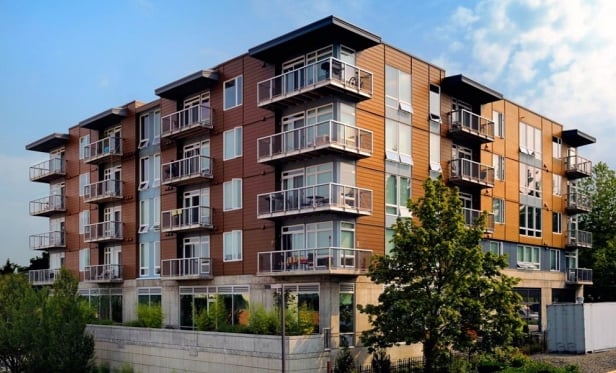 Luna Sol Apartments is located at 11415 Slater Ave. NE in the Eastside neighborhood.
Luna Sol Apartments is located at 11415 Slater Ave. NE in the Eastside neighborhood.
KIRKLAND, WA—Amazon, Facebook, Google and other tech giants continue to recruit thousands of new employees for positions in Seattle, supporting strong in-migration trends across the metro, according to a third-quarter report by Marcus & Millichap. And, a shortage of single-family housing and a rapidly growing economy is spurring more residents to rent.
With the city growing at such a rapid rate, housing affordability has become one of the greatest issues the metro faces. In King County, the median home price climbed 9% during the past year to $715,000, while in Snohomish County, the median passed $500,000 for the first time recently, generating strong demand for more affordable rental housing. With deliveries falling to the lowest point since 2012, year-end vacancy will decline for the first time in four years to maintain rent growth above 5% this year.
These factors have resulted in more multifamily acquisitions in the metro. A recent example is Luna Sol Apartments, a 52-unit podium-style apartment community that received financing in the amount of $14.5 million. The property was 98% occupied at closing.
Working exclusively on behalf of the borrower, Magma Equities, a Holliday Fenoglio Fowler LP team placed the floating-rate condo-conversion loan with a specialty finance company. Loan proceeds will be used to acquire, renovate and upgrade the property with the intent to sell individual units beginning in 2019.
“Luna Sol is an excellent example of how a creative sponsor combined with strong market fundamentals can support a strategic business plan like the conversion and sale of individual condo units in greater Seattle,” says HFF senior director Zack Holderman.
Luna Sol Apartments is located just west of Interstate 405 at 11415 Slater Ave. NE in the Eastside neighborhood. The property was originally constructed as a condominium development with residential units sitting atop separately owned ground-floor office units. Completed in 2010, Luna Sol features open one- and two-bedroom floor plans averaging 843 square feet, five of which are permanently designated as affordable housing units. Interior finishes include stainless steel appliances, glass-top stoves, full-sized washers and dryers, walk-in closets and floor-to-ceiling windows. Community amenities include a fitness center, secured lobby, underground parking, and courtyard with grills and outdoor seating.
The HFF debt placement team representing the borrower included Holderman and analyst Daniel Pinkus, along with local market assistance from director Zack Goodwin of HFF's Seattle office.
“With the tremendous economic growth and demand for high-quality affordable housing in the greater Seattle area, the sponsor was able to identify a project with the unique characteristics that would enable them to take a well-performing for-rent asset and transform the investment into a for-sale project,” Holderman tells GlobeSt.com. “Luna Sol will meet the demands of a workforce in need of entry-level homeownership, while providing a mix of affordable and market-rate units in a desirable, highly amenitized submarket.”
Lower entry-level pricing coupled with improving property performance are resulting in investor competition in more suburban locations, contributing to robust asset appreciation. In Pierce and Snohomish counties, the average price on a per-unit basis was up 20% during the past year from the prior period, though it still remains well below the overall metro average, says Marcus & Millichap.
Investors also remain active across pockets of Seattle, including the University District, Fremont, Capitol Hill and First Hill, where many trades were for less than $10 million. Tenant demand in these areas continually holds strong, keeping cash flow steady. Robust pricing growth during the trailing 12 months through June contributed to a 10-basis-point decline to the average cap rate, resting in the upper-4% area. Class-A properties traded in King County recently recorded an initial yield in the high-3 to low-5% band. Similar properties in Pierce and Snohomish counties traded for 80 basis points higher.
To stem the shortage of multifamily properties in the metro, construction continues on a robust trajectory, with Seattle leading the nation in crane count. Since the end of 2012, more than 50,000 apartments have been built across the Puget Sound, while another 20,000 units are winding through the pipeline, says the Marcus & Millichap report.
Developers remain focused on the neighborhoods of Seattle near mass transit, restaurants and entertainment, and roughly 30 complexes are underway on Capitol Hill and in the Central District. The South Lake Union and Queen Anne area follows with 23 buildings underway.
© 2025 ALM Global, LLC, All Rights Reserved. Request academic re-use from www.copyright.com. All other uses, submit a request to [email protected]. For more information visit Asset & Logo Licensing.








